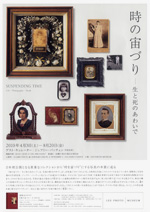 |
Picks is a monthly sampling of Japan's art scene, offering short reviews of exhibitions at museums and galleries in recent weeks, with an emphasis on contemporary art by young artists. |
 |
 |
|
|
 |
 |
 |
 |
| Suspending Time: Life - Photography - Death |
| 3 April - 20 August 2010 |
Izu Photo Museum, Shizuoka
(Shizuoka) |
 |
| The works gathered here are memorial photographs of the deceased -- the sort one commonly sees placed on the altars at Japanese funerals. There is nothing "special" about these portraits, yet to view them is a thrilling and fulfilling experience, for they vividly evoke the power of photography to "suspend its subjects between life and death." If curators had more sense, there would be more such exhibitions at other art museums in Japan. |
|
|
 |
|

|
 |
 |
 |
|
Ito Jakuchu |
| 19 March - 13 June 2010 |
Kotohiragu
(Kagawa) |
 |
| The Kotohiragu shrine on Shikoku island is home to some renowned murals by the legendary artist Ito Jakuchu (1716-1800). Last year the Kyoto National Museum completed restoration work on the shrine's inner Jodan-no-Ma room, which contains Ito's Hanamaru-zu (Pictures of Flowers). Normally closed to the public, the room is open for viewing this year until mid-June. An adjoining exhibit compares the pre- and post-restoration Hanamaru-zu, amply demonstrating how much work was done on certain parts of the mural, particularly on the colors. |
|
|
 |
 |
|
|
Manet et le Paris moderne |
|
|
Mitsubishi Ichigokan Museum, Tokyo
(Tokyo) |
 |
| Designed by British architect Josiah Conder and completed in 1894 as downtown Tokyo's first modern office building, the red-brick Mitsubishi Ichigokan is a fine example of Queen Anne architecture. The original was torn down in 1968, but the edifice has now returned to life as an art museum. Commemorating its April 2010 reopening is Manet et le Paris moderne. While "The Luncheon on the Grass" and "Olympia" are missed, we do get "Lola de Valence," "Émile Zola," and "Berthe Morisot" -- all in all, one of the most definitive Manet exhibitions in Japan to date. |
|
|
|
|
|
|
|

|
 |
 |
|